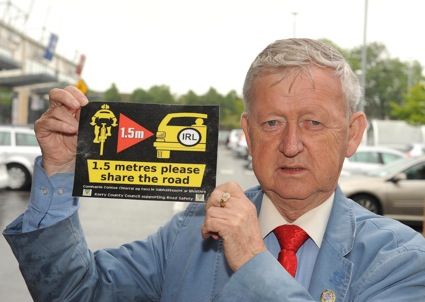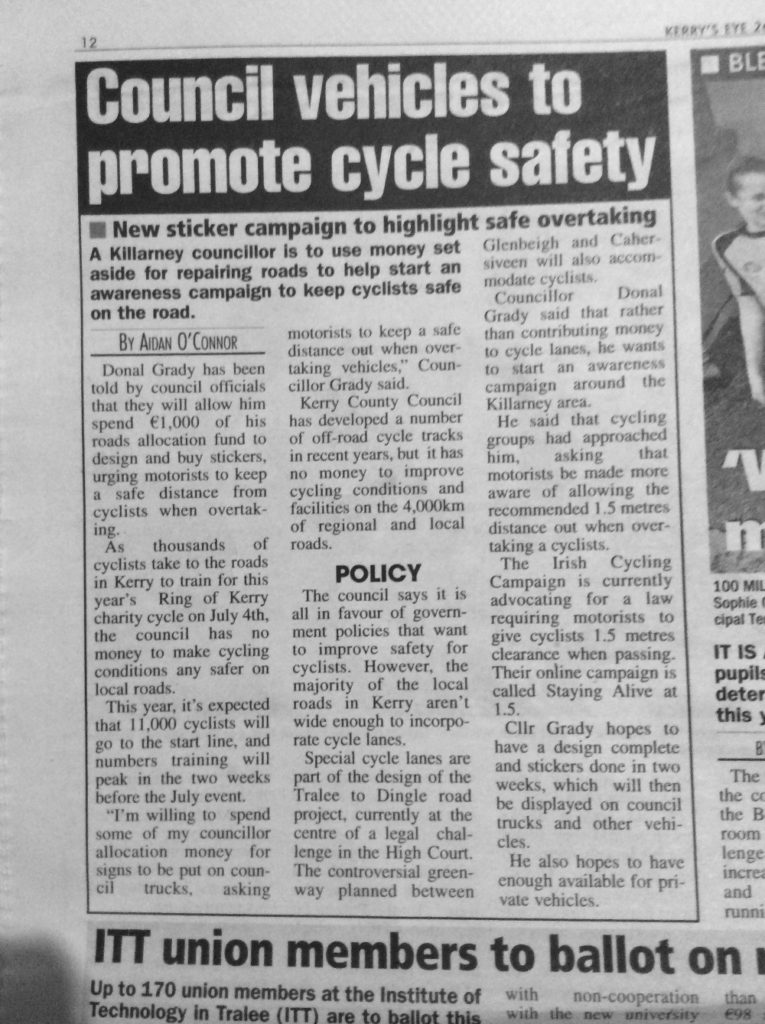How many times have you heard the phrase ‘shur all cyclist break the lights‘ ? this missive is often rolled out when anything cycle related is being discussed in the media and almost always without facts to back it up.
This was the just the case last Thursday on Radio Kerry when the question was asked if people thought that automated cameras should be deployed at junctions in Kerry in order to catch drivers who break red lights, referencing the launch of the countries first automated red light camera system that morning in Dublin.
Right on cue the first comment (from Tom in Killarney) was ‘what about all the cyclists who break the lights ?’, we contacted Radio Kerry to counter Tom’s comment and were invited to speak on the issue. In the interview we got to speak about the issue of red light violations and how rather that victimising cyclists it would be more beneficial to question why a small number of cyclist break light and how junctions could be designed to cater for cyclists in order to avoid these infractions.
There has been very little in research into red light violations in Ireland but there was one study which we were aware of, coincidentally this was part of the pilot programme for the Red Light Camera Project, the very project that just launched in Dublin on Thursday and analysing the very same junctions, in short you could not find a better example.
As part of the pilot project the Railway Procurement Agency (RPA) studied two junctions along the Luas Red line, Blackhall Place and Con Colbert Road in 2011, these were chosen due to the high number of Road Traffic Collisions at the junctions and the risk these posed to Luas passengers. The study analysed the red light violations which took place, as well as the vehicle type, time of day, day of the week and time after the red light was displayed.
Source: Railway Procurement Agency – Red Light Camera Project
The results of the study are clear, drivers are far more likely to break red lights than cyclists, of all the red light violations approximately 15% were committed by cyclists, with almost 85% committed by motor vehicles.
Not only are those in motor vehicles more likely to break lights, but they are also have the potential to cause far more harm than a person on a bike, something which was also acknowledged within the report:
In considering the potential impact of red light violations an important factor is the class of vehicle. Cyclist violations are generally not comparable with those of motorised vehicle … therefore for comparison of results it is beneficial to exclude them from this part of the discussion.
So when we have far more cars than bikes on our roads, which break the lights more often and are far more lethal in the event of a collision, why is there so much public venom directed at cyclists ?
The conversation then turned to infrastructure, or the lack of in many cases when you consider cycle infrastructure, in Dublin the same amount of commuters are carried each day by bike as are carried by the Luas. The initial Luas lines cost €728m to create and is hailed as a great success, but despite having a similar capacity cycling receives a tiny amount of funding in comparison.
Of course the Luas has yet to reach the kingdom and public transport in general throughout the county is pretty limited, which makes investment in cycling infrastructure even more impactful. According to the latest CSO figures almost as many people in Killarney get to work or school by bike as get there by use of public transport, in Tralee four times as many people commute by bike compared to public transport while on a county level approximately a third more Kerry people use bicycles compared to buses and trains to work or education.
Source: Central Statistics Office – Census (2011)
While these statistics may seem to paint a positive picture for cycling in Kerry they may have more to do with the lack of public transport than anything else, that said at approximately 4% Tralee has one of the highest rates of cycle commuters in the country, but country wide the rate is just 1.5%.
The government has set an objective (in the National Cycle Policy Framework) that by 2020 10% of all journeys will be made by bike, so how do we in Kerry get from 1.5% to 20% within the next 5 years ? One thing we can be sure of is that the culture of victimisation and targeting of cyclists with fines for not paying heed to substandard infrastructure is not going to get us there, but traffic lights could be a good place to begin…
- Traffic Light that work for cyclsits
There are a number of traffic lights in the county which do not work even on a basic level for cyclists, for example the lights right outside Radio Kerry will not turn green for cyclist, which means that cyclist who stop at a red light at this junction have to wait for a car to join them before the lights turn green ! - Advance Stop Line
One reason cyclists have been know to start off just before a green signal is in order to get a head start on cars and trucks in order to ensure their safety. Advance Stop Line (ASL’s) allow cyclist to take up position ahead of cars which in turn provide safety as cyclists are more visible to motorists. There are only a few ASL’s in Kerry. - Left turn at a red light
Some countries permit cyclists make a left turn at a red light (but more often in left hand drive countries where it is of course right turn at a red light) provided the road is clear. - Straight on red when there is no road joining to the left
Similar to Left turn on red but allowing a cyclist to proceed with caution provided the road is clear when there is no road junction to the left. - Bicycle traffic lights
We are not aware of any of these light in Kerry - Headstart for cyclists
When bicycle traffic lights are in use these can be set to turn green a few second before the main lights which allow cyclist head start on cars and trucks in order to ensure their safety.
Call for infrastructure overhaul for Kerry cyclists – Radio Kerry

